Okehampton
Okehampton. Stunning contrasts - Once on the edge of mountains, this area weathered by aeons of time, still strikes a spectacular pose. Yes Tor at 2,031 ft and Willhays, 2039 ft, the highest peaks on Dartmoor towering south of the town. With its softer pose of pleasing northern Devon landscape, the area brings a beauty that contrasts, delights and bids you welcome.
Okehampton is the heart of activity in central Devon. Walking trails and cycle paths all start in the town or are not very far away. Very important central point.
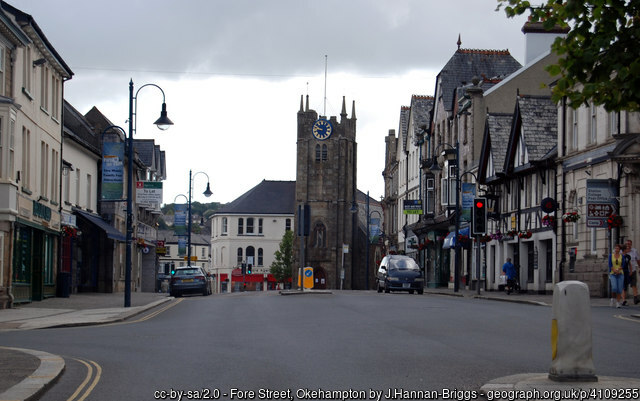
Fore Street, Okehampton
Photograph © J.Hannan-Briggs
If all the activity of this town makes you feel tired, Okehampton is a pleasant and interesting place to visit either for a short break or a quiet holiday in itself. The surrounding area has plenty of attraction for the holiday maker.
The pleasing town itself is a busy centre – not surprisingly with all the activities going on. Small shops run by local people as well as larger concerns cater to both community and visitor alike. The main street is wide and not so busy since the bypass. Narrow lanes lead off this main street. The Town Hall was originally a house.
Plenty of accommodation is available – bed and breakfast, self catering and hotels.

Simmons Park
Was designed and gifted to the people of of the town by Sydney Simmons in
1907. Its green, tranquil mature parkland on the banks of the East
Okement River can be found in the centre of the town. A delight for relaxation! Or just a quiet stroll.

Okehampton Castle
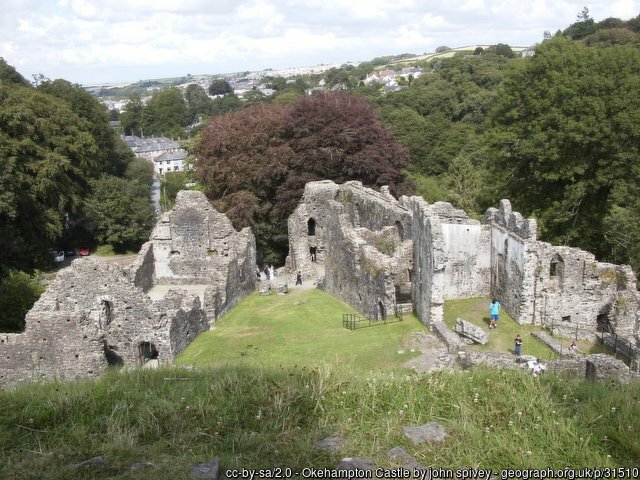
Okehampton Castle
Photograph © john spivey
The Norman Conquest of 1086 had its effect in the town when Baldwin de Brion was granted the estate and built Okehampton Castle.
Said to be a fine structure and the biggest in Devon. It is now in ruins. Henry VIII had an argument with the Earl of Devon, Hugh Courteney in 1538. Said Countenay was conspiring against him.
The walls rising from the mount are still impressive and it is a very pleasant picnic spot – but haunted!!!!
English Heritage run the site and there is a shop with picnic tables, refreshments and guidebooks as well as the usual souvenirs.

Museum of Dartmoor Life
The Museum of Dartmoor Life in West Street, tells of the growth of the town from its earliest days. Set in a courtyard the museum follows a route showing what life was really like on Dartmoor – before electricity or modern shops or plumbing! What was it like to be a tin miner, a farmer a housewife. You can even mint your own medieval coin! A shop and tea rooms are on the site.

Walking Trails and Cycle Paths
The walking and cycling trails all have their own interest. Some are very long and make a holiday on their own or can be broken up for shorter breaks. Others can be completed in a day. Allow plenty of time for sidetracks! It is so easy to get side tracked on these delightful walks long or short!
There are also several shorter cycle routes in and around the town.
Tarka Trail
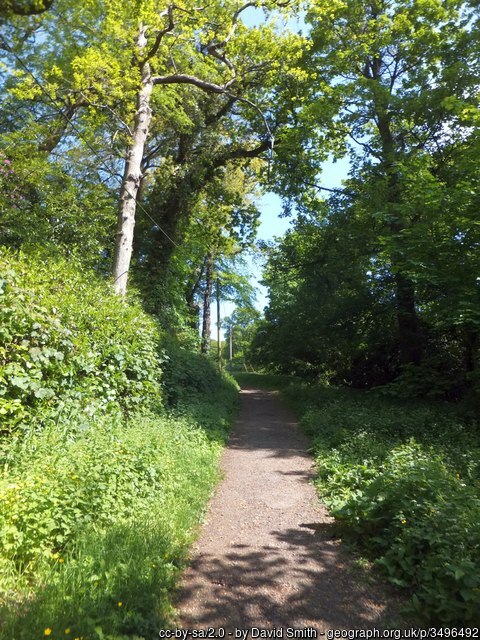
Tarka Trail near Okehampton
Photograph © David Smith
Okehampton is the centre of the figure of eight - 180 mile trail following the scenes of “Tarka the Otter”, Henry Williamson’s famous, well loved novel and cute star of the film of the same name narrated by Peter Ustinov. Some of the way is moorland, some of the way river scenery.
Devon Coast to Coast
102 miles - Ilfracombe to Plymouth cycle and walking path. Much of it travels along the old railway lines. It takes in beautiful rivers, estuaries and moors. At different points the Tarka Trail, Granite Way and the Plym Valley Trail each form part of the route.
Dartmoor Way
A 90 mile circular cycle and walking path round the edge of Dartmoor. The cycle and walking paths are separate. Allow time to side track and visit some interesting places along the Way. Take the camera or camcorder there are stunning views. Please read Dartmoor Trails before tackling moorland walks.
West Devon Way
36 miles from Okehampton to the south coast at Plymouth. Fairly easy walking across moorland, river valleys and beautiful Devon farmland.
Granite Way
11 miles from Okehampton to Lydford. A cycle and walk pathway. This route is new. Spectacular. Mostly off road.
Ten Tors Walk
This delightful town is the start of the Ten Tors Walk. A famous walking challenge for young people held annually on Dartmoor in May.
Two Moors Way
The start of Two Moors Way is close by at Ivybridge. 102 miles. Crosses both Dartmoor and Exmoor and the Ruby valley between. Finishes at Lynmouth on the north coast of Somerset.
Monkokehampton Cycle route
20 miles. Leaves and returns to the town on the NCN27. On quiet lanes with some steep hills. The sort of ride one should take ones time, too pleasant to rush. Mind the cars on the narrow roads, some drivers do not know how to tackle these roads.
Drogo and Chagford Cycle route
18 or 28 miles if the extension is taken.
Hatherleigh and Follygate cycle route
20 miles
Lewtrenchard cycle route
25 miles

Places to visit outside Okehampton
Meldon Viaduct
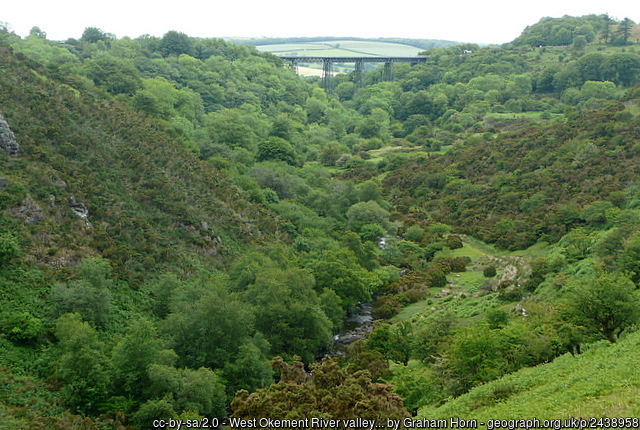
Meldon Viaduct in the distance
Photograph © Graham Horn
Is worth a visit. Was a railway line and is now part of the Granite Way. Magnificent views into the deep gorge and out over the moor.
Similarly named Meldon Reservoir – a stunning dam – 900 ft above sea level. It is not possible to walk close to the dam but moorland walks overlook.
Sticklepath
The name means 'steep path' in Saxon. National Trust site – The interesting Finch Foundry is a water powered forge factory and is still working.
Belstone
Attractive village near Nine Maidens stone circle.
Lydford
Is a small village on the River Lyd. An amazing walk down Lydford Gorge is quite an experience, but should only be undertaken by fit folk! National Trust site with a shop.

History of Okehampton
Habitation can be traced back over 2000 years to the Neolithic and Bronze Ages. Evidence and artefacts have been found and are still being found on the moorland nearby.
The Romans built a fort near the town and another at North Tawton.
The Saxons had a village here – certainly by the 7th century. Their church was on the site of the present one. Recorded mention of Saxon times comes in 980 when the village is known as Ocmundtune – meaning settlement by the Okement, which of course is still the name of the rivers – the East and West Okements. This record is of slaves in Saxon times being freed to choose their own destiny at a cross roads in Okehampton.
The Norman conquest saw the building of Okehampton Castle.
The 1549 Prayer Book Rebellion
A rising of angry Devon and Cornishmen against the introduction of the Prayer Book in English, finished at Sampford Courtenay near Okehampton. They wanted their familiar Latin to continue. Cornishmen did not consider themselves English, but a separate state. Their language was Cornish not English. Cornish is closely related to Breton an area in France related to the Cornish folk. The rebels did not stand a chance against the government forces.
Royalists and Roundheads
During the Civil War in the middle of the 1600’s both had garrisons in the town – at different times of course. The war raged around the country, Devon and Cornwall were not out of it. The Battle at Stourton Down in 1643 not far from away from the town was between the Royalists pushing out from Cornwall as the Roundheads retreated. Both sides were at times winning and then retreating. It was a massive storm that settled the issue, the Royalists retreated leaving everything behind.

Famous People of the town

Wiliam Pitt the Elder
Two famous men, Clive of India and William Pitt the Elder, represented the town in Parliament before the 'Rotten Boroughs' were abolished.

Other pages that may be of interest

Return from Okehampton to Home
Or you may prefer to browse some more, please do, there are navigation buttons above on the left.

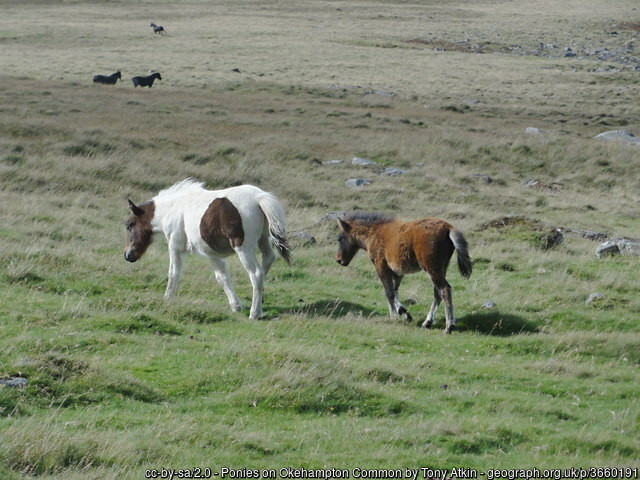
Ponies on Okehampton Common
Photograph © Tony Atkin

Useful Information
Things change. Always check out the external links for the latest information.
These are just helpful suggestions only.
There is only one affiliate link, SBI.
Travel Wessex is a Guide.


This is a developing map. Some areas have better coverage.
To find the nearest Electric Vehicle Charging Point please click here.

Public Transport
If you do decide the leave the car at home and help the environment too, why not go National Express. They run coaches all over the country. Some pretty good fares too.
Just imagine - sit back and relax, no hassling with the traffic!!!
Do you know that you can book on your mobile phone and they will send the ticket as a text!!!!

National Rail Journey Planner.
For train journeys all over the United Kingdom connecting the places you want to go efficiently and quickly.

Traveline is a very useful resource for public transport throughout Wessex, even local buses. In fact all over the United Kingdom.



